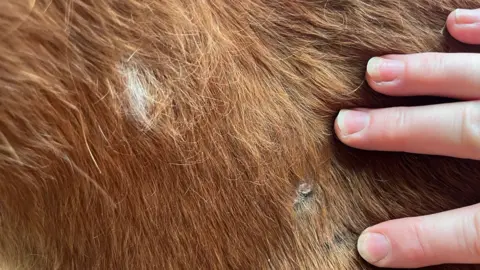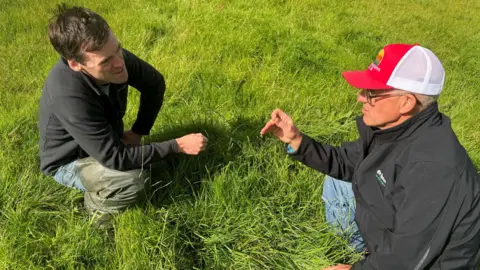WWIII
US researchers identify launch site of Russia’s new nuclear-powered missile
Euractiv.com with ReutersSep 2, 2024

Illustrative photo. An activist from IPPNW Germany and ICAN Germany wears a mask of Russian President Vladimir Putin, as he holds a mock missile during a demonstration against the ending of the Intermediate-Range Nuclear Forces Treaty (INF) in front of the American Embassy at Pariser Platz in Berlin, Germany, 1 August 2019.
[EPA-EFE/OMER MESSINGER]
Euractiv is part of the Trust Project >>>
Two US researchers say they have identified the probable deployment site in Russia of the 9M370 Burevestnik, a new nuclear-powered, nuclear-armed cruise missile touted by President Vladimir Putin as “invincible.”
Putin has said the weapon – dubbed the SSC-X-9 Skyfall by NATO – has an almost unlimited range and can evade US missile defences. But some Western experts dispute his claims and the Burevestnik’s strategic value, saying it will not add capabilities that Moscow does not already have and risks a radiation-spewing mishap.
Using images taken on 26 July by Planet Labs, a commercial satellite firm, the two researchers identified a construction project abutting a nuclear warhead storage facility known by two names – Vologda-20 and Chebsara – as the new missile’s potential deployment site. The facility is 475 km north of Moscow.
Reuters is the first to report this development.
Decker Eveleth, an analyst with the CNA research and analysis organisation, found the satellite imagery and identified what he assessed are nine horizontal launch pads under construction. They are located in three groups inside high berms to shield them from attack or to prevent an accidental blast in one from detonating missiles in the others, he said.
The berms are linked by roads to what Eveleth concluded are likely buildings where the missiles and their components would be serviced, and to the existing complex of five nuclear warhead storage bunkers.
The site is “for a large, fixed missile system and the only large, fixed missile system that they’re (Russia) currently developing is the Skyfall,” said Eveleth.
Russia’s defence ministry and Washington embassy did not respond to a request to comment on his assessment, Burevestnik’s strategic value, its test record and the risks it poses.
A Kremlin spokesman said these were questions for the defence ministry and declined further comment.
The US State Department, the CIA, the Office of the Director of National Intelligence and the US Air Force National Air and Space Intelligence Center declined to comment.
The identification of the missile’s probable launch site suggests that Russia is proceeding with its deployment after a series of tests in recent years marred by problems, said Eveleth and the second researcher, Jeffery Lewis, of the Middlebury Institute of International Studies at Monterey.
Lewis agreed with Eveleth’s assessment after reviewing the imagery at his request. The imagery “suggests something very unique, very different. And obviously, we know that Russia is developing this nuclear-powered missile,” he said.
Hans Kristensen of the Federation of American Scientists, who also studied the Vologda imagery at Eveleth’s request, said that it appears to show launch pads and other features “possibly” related to Burevestnik. But he said he could not make a definitive assessment.
Eveleth, Lewis, Kristensen and three other experts said Moscow’s normal practice has been stockpiling nuclear payloads for land-based missiles far from launch sites – except for those on its deployed Intercontinental Ballistic Missile (ICBM) force.
But deploying the Burevestnik at Vologda would allow the Russian military to stockpile the nuclear-armed missiles in its bunkers, making them available to launch quickly, said Lewis and Eveleth.
Deputy Foreign Minister Sergei Ryabkov said Russia will make changes to its guidelines on the use of nuclear weapons in response to what it regards as Western escalation in the war in Ukraine, state news agency TASS reported on Sunday.
Two US researchers say they have identified the probable deployment site in Russia of the 9M370 Burevestnik, a new nuclear-powered, nuclear-armed cruise missile touted by President Vladimir Putin as “invincible.”
Putin has said the weapon – dubbed the SSC-X-9 Skyfall by NATO – has an almost unlimited range and can evade US missile defences. But some Western experts dispute his claims and the Burevestnik’s strategic value, saying it will not add capabilities that Moscow does not already have and risks a radiation-spewing mishap.
Using images taken on 26 July by Planet Labs, a commercial satellite firm, the two researchers identified a construction project abutting a nuclear warhead storage facility known by two names – Vologda-20 and Chebsara – as the new missile’s potential deployment site. The facility is 475 km north of Moscow.
Reuters is the first to report this development.
Decker Eveleth, an analyst with the CNA research and analysis organisation, found the satellite imagery and identified what he assessed are nine horizontal launch pads under construction. They are located in three groups inside high berms to shield them from attack or to prevent an accidental blast in one from detonating missiles in the others, he said.
The berms are linked by roads to what Eveleth concluded are likely buildings where the missiles and their components would be serviced, and to the existing complex of five nuclear warhead storage bunkers.
The site is “for a large, fixed missile system and the only large, fixed missile system that they’re (Russia) currently developing is the Skyfall,” said Eveleth.
Russia’s defence ministry and Washington embassy did not respond to a request to comment on his assessment, Burevestnik’s strategic value, its test record and the risks it poses.
A Kremlin spokesman said these were questions for the defence ministry and declined further comment.
The US State Department, the CIA, the Office of the Director of National Intelligence and the US Air Force National Air and Space Intelligence Center declined to comment.
The identification of the missile’s probable launch site suggests that Russia is proceeding with its deployment after a series of tests in recent years marred by problems, said Eveleth and the second researcher, Jeffery Lewis, of the Middlebury Institute of International Studies at Monterey.
Lewis agreed with Eveleth’s assessment after reviewing the imagery at his request. The imagery “suggests something very unique, very different. And obviously, we know that Russia is developing this nuclear-powered missile,” he said.
Hans Kristensen of the Federation of American Scientists, who also studied the Vologda imagery at Eveleth’s request, said that it appears to show launch pads and other features “possibly” related to Burevestnik. But he said he could not make a definitive assessment.
Eveleth, Lewis, Kristensen and three other experts said Moscow’s normal practice has been stockpiling nuclear payloads for land-based missiles far from launch sites – except for those on its deployed Intercontinental Ballistic Missile (ICBM) force.
But deploying the Burevestnik at Vologda would allow the Russian military to stockpile the nuclear-armed missiles in its bunkers, making them available to launch quickly, said Lewis and Eveleth.
Deputy Foreign Minister Sergei Ryabkov said Russia will make changes to its guidelines on the use of nuclear weapons in response to what it regards as Western escalation in the war in Ukraine, state news agency TASS reported on Sunday.

Russia says it will change nuclear doctrine because of Western role in Ukraine
Russia will make changes to its doctrine on the use of nuclear weapons in response to what it regards as Western escalation in the war in Ukraine, state media quoted Deputy Foreign Minister Sergei Ryabkov as saying on Sunday (1 September).
Poor test record
A 2020 report by the United States Air Force’s National Air and Space Intelligence Center said that if Russia successfully brought the Burevestnik into service, it would give Moscow a “unique weapon with intercontinental-range capability”.
But the weapon’s checkered past and design limitations raised doubts among eight experts interviewed by Reuters about whether its deployment would change the nuclear stakes for the West and other Russian foes.
The Burevestnik has a poor test record of at least 13 known tests, with only two partial successes, since 2016, according to the Nuclear Threat Initiative (NTI), an advocacy group focused on reducing nuclear, biological and emergent technology risks.
The setbacks include a 2019 blast during the botched recovery of an unshielded nuclear reactor allowed to “smolder” on the White Sea floor for a year following a prototype crash, according to State Department reports.
Russia’s state nuclear agency Rosatom said five staff members died during the testing of a rocket on 8 August. Putin presented their widows with top state awards, saying the weapon they were developing was without equal in the world, without naming the Burevestnik.
Many experts are skeptical of Putin’s claims.
The Burevestnik, they say, could have a range of some 15,000 miles (23,000 km) – compared to more than 11,000 miles (17,700 km) for the Sarmat, Russia’s newest ICBM – while its subsonic speed would make it detectable.
“It’s going to be as vulnerable as any cruise missile,” said Kristensen. “The longer it flies, the more vulnerable it becomes because there is more time to track it. I don’t understand Putin’s motive here.”
The Burevestnik’s deployment is not banned by New START, the last US-Russian accord limiting strategic nuclear weapon deployments, which expires in February 2026.
A provision allows Washington to request negotiations with Moscow on bringing the Burevestnik under the caps but a State Department spokesperson said no such talks had been sought.
Citing the war in Ukraine, Russia has spurned US calls for unconditional talks on replacing New START, stoking fears of an all-out nuclear arms race when it expires.
(Edited by Georgi Gotev)












 Ferne Animal Sanctuary
Ferne Animal Sanctuary


